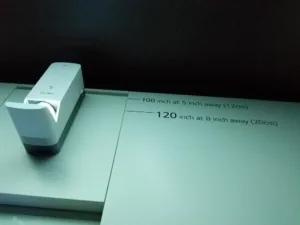In this article, we are covering the main projectors, while those that are being really aimed at TV replacement are covered in this article (TV Projectors at CES).
LG Electronics introduced a new projector aimed at the home theater enthusiast market and with a unique form factor. It is a tower-type device that can sit on the floor with a handle that swings up to carry it away. The top is actually a mirror to reflect light beaming upwards or out horizontally to fill a screen or wall surface. It can also be mounted on a wall or ceiling.
The HU80KA offers 8M pixels on screen using a 0.66” DLP chip with a two-position image shifting optic. It is powered by a laser phosphor engine, outputs 2500 lumens and has HDR10 decoding support. There was no specification on the color gamut (which is often barely rec. 709 in most laser phosphor projectors – CC). It uses LG’s webOS with SmartTV functionality to access Netflix, Amazon and other streaming services. Screen sizes up to 150” are supported, says the company. It has two internal 7W speakers, but external speakers or a sound bar can be used as well via optical output, HDMI or wireless Bluetooth. One clever innovation: the power cord retracts in the device like a cord on a vacuum cleaner.
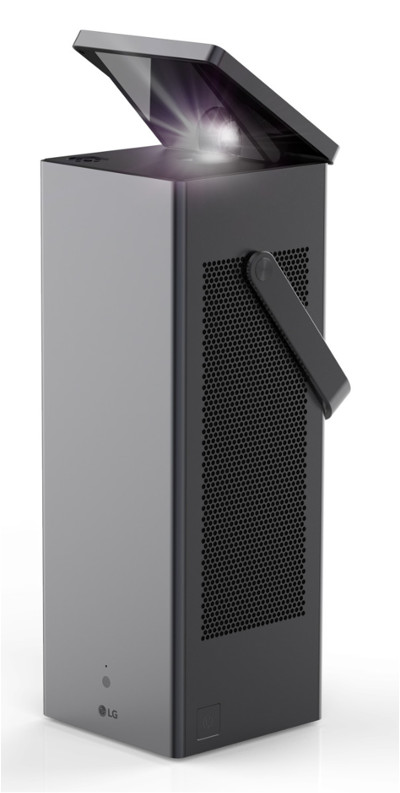
LG also showed other projectors in its growing line up. This included the HF85JA, which is an ultrashort throw laser-phosphor projector with 1500 lumens and FHD resolution. It also has WebOS and SmartTV functionality. It can create a 120” image from a distance of 8” from the screen.
The sister HF80JA has a more conventional lens with zoom capabilities, but is otherwise the same performance and functionality.
ViewSonic is one of the projector brands that is now targeting the home theater market with the new 0.47” 4-shifter DLP chip set that produces 8M pixels (UHD) on screen. The new competitive price point for this class of projector is $1500, which is what the ViewSonic PX727-4K model is going for. It should be available in February, 2018.
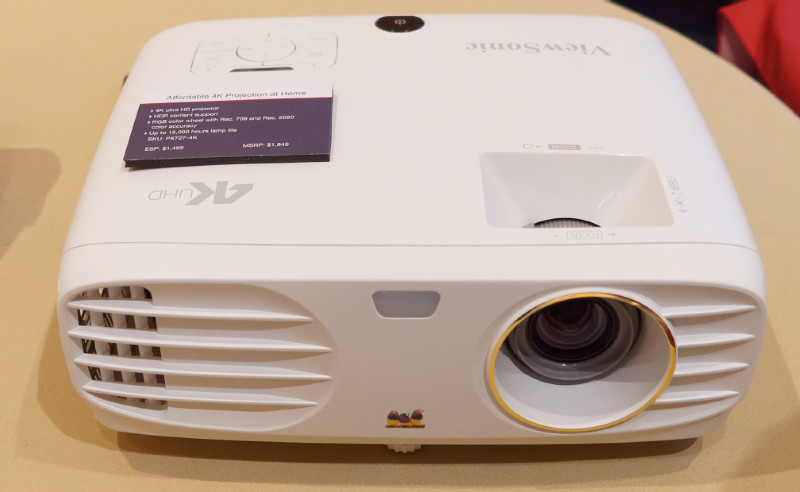
ViewSonic says the projector is HDR10 compatible and will decode colors encode with 709 or 2020 primaries. It claims “DCI-P3” coverage using its exclusive SuperColor six-segment RGBRGB color wheel. Output is speced at 220 lumens with dynamic contrast of 12,000:1. There is a 1.2X optical zoom and a built-in 10W speaker.
Interestingly, this is a lamp-based model, but lamp life in SuperEco-mode is specified at 15K hours. More expensive laser phosphor versions typically spec the lifetime (to 50% of initial luminance) at 20K hours, so not a lot longer. However, there is no spec on the color gamut and/or light output in this mode to judge if is actually useful or not.
Optoma also debuted a new UHD projector using the 0.47” 4-shifter DMD. Dubbed the UHD50, it offers 2,400 lumens, 500,000:1 dynamic contrast, a six-segment RGBRGB color wheel, HDR10 support, 2020 decoding and a wide color gamut (no spec provided).
In addition to performance that looks superior to the ViewSonic UHD model, the UHD51A can come with Amazon Alexa installed. Optoma told us there are 18 commands recognized by the Alexa engine. This includes common needs like switching inputs, adjusting the volume or launching content. The big advantage – you don’t necessarily need the remote any more (and can survive when you lose it).
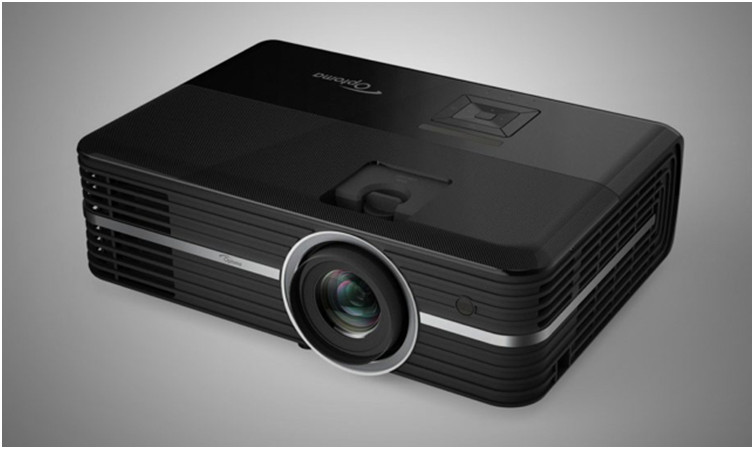
The UHD50 will retail for $1499 while the UHD51A will retail for $1699. Both will be available in February.
Optoma was also showing a High Lumen Density (HLD) demo, with the solid state light source provided by Philips. This can obtain 3000 lumens and 70% of the BT.2020 color gamut. It may launch this fall.
The company also had the L/P-based UH65, in a UST configuration and with 2,300 lumens of output and HDR10 support. It is expected around mid-year and will cost around $5,000. A lamp-based version is also likely to follow. More details will be released as shipping gets closer.
The third product introduced at CES based on the 4-shifter chip set was from Acer who had the V6820i 4K UHD model. Like the Optoma model, it also embeds Amazon Alexa support. A sister V6820M includes Alexa but is not 4K.
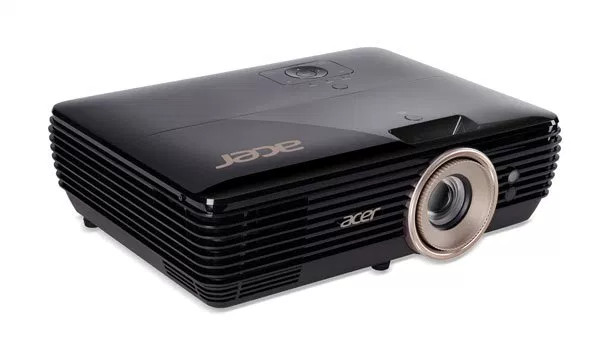
Acer also announced it was installing Alexa on its PCs as well. This means consumers will be able to control the projector after enabling the Acer Projector Smart Home skill by asking Alexa on a device like the Echo or compatible Acer PC, “Alexa, turn on the projector,” “Alexa, select HDMI as the projector source,” or “Alexa, change projector display mode to bright.”
Specifications are probably similar to the Optoma model (they have not been released but we think they are both made by Coretronics). Acer includes what it calls AcuMotion, which is a frame interpolation system to generate intermediate frames to smooth out motion of fast moving objects.
MirraViz was in the ChangHong booth at CES so there must be a connection, but we did not find out what it is. MirraViz was showing a single screen with three pocket projectors shining on it. As you walked horizontally past it, you would see three different movies being shown. The company thinks this is a good idea for gamers to share the same screen, but I am not convinced. (MirraViz Offers Multiple Content Shown on One Projector Screen at the Same Time)
The viewing position is very limited – you need to be at the right distance and the horizontal sweet spot is pretty narrow. The pocket projectors have limited brightness but the special screen offers “200X the brightness of the projector,” says the company. It looks as though this screen is constructed with retro-reflectors to beam the light back toward the projector. But there may be another optical layer to explain the distance dependence, perhaps a lenticular layer.
The company has changed its business model from a turnkey solution to offering to sell the screen only with the customer buying their own projectors. The screens start at $499 with sizes up to 94”. But not any projector is suitable – high quality DLP-based units are needed and the company is now working on a list of acceptable models.

Changdu XGimi Technology was showing its Aurora LED projector in the CES Innovations award area that is said to be useful for displays up to 180″ (although we wouldn’t do that! Man. Ed.) The unit has JBL audio and has an integrated Android OS and a 20,000 mAh battery.
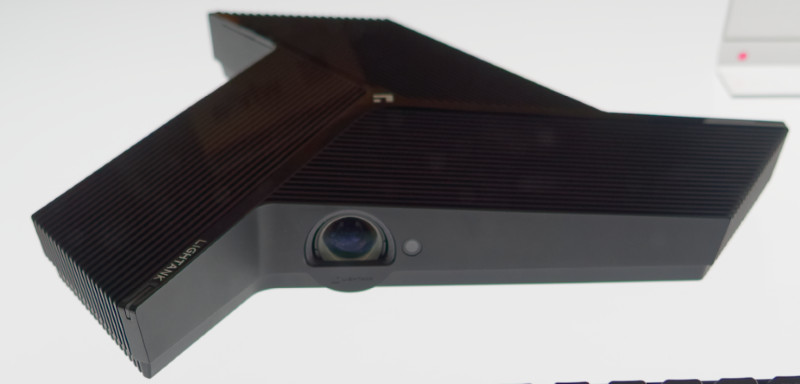 Changdu XGimi had a wireless LED projector that won an Innovation Award. Image:Meko
Changdu XGimi had a wireless LED projector that won an Innovation Award. Image:Meko

